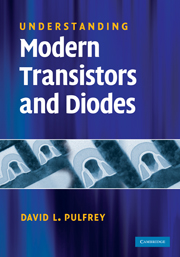Book contents
- Frontmatter
- Contents
- Preface
- 1 Introduction
- 2 Energy band basics
- 3 Electron and hole concentrations
- 4 Thermal equilibrium
- 5 Charge transport
- 6 np- and Np-junction basics
- 7 Solar cells
- 8 Light-emitting diodes
- 9 HBT basics
- 10 MOSFET basics
- 11 HJFET basics
- 12 Transistor capacitances
- 13 Transistors for high-speed logic
- 14 Transistors for high frequencies
- 15 Transistors for memories
- 16 Transistors for high power
- 17 Transistors for low noise
- 18 Transistors for the future
- Appendices
- Index
9 - HBT basics
Published online by Cambridge University Press: 05 June 2012
- Frontmatter
- Contents
- Preface
- 1 Introduction
- 2 Energy band basics
- 3 Electron and hole concentrations
- 4 Thermal equilibrium
- 5 Charge transport
- 6 np- and Np-junction basics
- 7 Solar cells
- 8 Light-emitting diodes
- 9 HBT basics
- 10 MOSFET basics
- 11 HJFET basics
- 12 Transistor capacitances
- 13 Transistors for high-speed logic
- 14 Transistors for high frequencies
- 15 Transistors for memories
- 16 Transistors for high power
- 17 Transistors for low noise
- 18 Transistors for the future
- Appendices
- Index
Summary
The first commercial bipolar junction transistors (BJTs) were made from germanium. Because of the low bandgap of this material (0.67 eV), the intrinsic carrier concentration is high. As ni increases exponentially with temperature (see (4.19)), these Ge BJTs were unstable, unless operating in a temperature-regulated circuit. Silicon, with its larger bandgap, proved to be a better proposition, and the first Si BJTs appeared in the early 1950s. These transistors ushered in the era of solid-state electronics. They were not challenged until MOSFETs started to appear in the 1960s, and to provide a superior transistor for circuits in which a high input impedance was important. With the advent of CMOS in 1963, the age of large-scale integration began, and the MOSFET became the more ubiquitous transistor. However, as we show elsewhere in this book, the bipolar transistor has inherent advantages in high-frequency performance, due to its superior transconductance, and in high-power applications, due to its favourable geometry. BJTs are also more robust than MOSFETs, which is why many readers will have become familiar with them during their electronics laboratory classes.
Perhaps the biggest event in BJT development in the last 20 years has been the advent of heterojunction bipolar transistors (HBTs). In the single heterojunction version of these transistors, dissimilar semiconducting materials are used for the emitter and the base, whereas the base and collector are made from the same semiconductor.
- Type
- Chapter
- Information
- Understanding Modern Transistors and Diodes , pp. 153 - 168Publisher: Cambridge University PressPrint publication year: 2010



